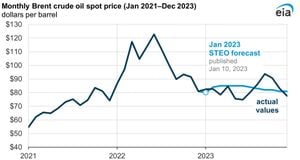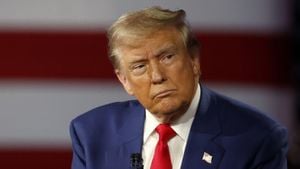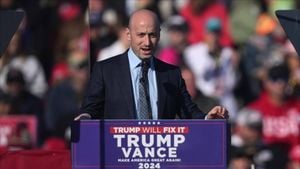With the 2024 presidential election heating up, Kamala Harris’s campaign strategy is under scrutiny. Many wonder whether her decisions will fortify her path to the presidency or lead to significant setbacks. One of the most important blunders under consideration is the simple act of skipping the Al Smith Dinner—a long-standing political tradition seen as instrumental for candidates.
The Al Smith Dinner is not just any political soirée; it has become almost obligatory for presidential candidates since the storied 1960 event with John F. Kennedy. This gathering of influential figures from both parties often serves as the perfect stage for candidates to display their charisma and humor, connecting with voters on both sides. Historically, it has helped candidates redefine their campaigns—think of Kennedy’s performance, which allowed him to effectively diffuse skepticism surrounding his Catholicism.
Yet, reports indicate Harris’s absence could be interpreted more negatively than her campaign anticipated. The only other nominee to miss this event, Walter Mondale, later lost to Ronald Reagan. Critics argue this absence may give the impression Harris is dodging challenging political interactions at a time when fostering relationships and building networks is more pivotal than ever.
Ethnic and religious identities also play a unique role at political functions like this. Given the demographic diversity of the Democratic Party and the importance of reaching out to specific key communities, skipping such dinners could signify a lack of outreach. With Republicans continuing to expand their presence across state governments, the burden rests heavily on Democratic leadership to unify and energize their base as they head toward the general election.
Meanwhile, away from traditional political events, the atmosphere at Harris’s awaited election night watch party took on its own drama. Set to occur at Howard University—Harris’s alma mater—anticipations ran high. Originally, students gathered enthusiastically, ready for the exciting occasion of celebrating their alum assuming one of the most powerful positions in the country. This was not just another election for them; it was monumental.
Things took a dramatic turn, especially after major states such as Georgia and North Carolina were projected for Donald Trump. The initial joy faded quickly, moving toward tension as defeat became increasingly palpable. Cori Ross, a 20-year-old student, captured the mood succinctly as she expressed her earlier excitement, only to confront the sobering reality. People began to exit the campus, slowly realizing their candidate might not secure the win as they had dreamed.
Despite early voting data indicating heightened turnout among women—who historically have leaned Democratic—the tide began to shift significantly. Also notable was the symbolism of where the event was planned—Howard University, regarded as one of the premier historically black colleges and universities (HBCUs) and rich with its own historical significance. Many of Harris's supporters wore attire proudly displaying their Alma Mater’s colors and symbols, yet as projections began to turn against her, the campus's energy plummeted.
Trapped between hope and anxiety, attendees felt the pressure mount. The significance of Harris’s candidacy was not solely based on her political stance but also the potential trailblazing effect for women and minorities. This added layer heightened expectations and left many, including students like Dru Strand, pondering the stakes involved. "It's extremely nerve-wracking," she stated, encapsulating the anxiety felt across Howard's campus.
Interestingly, much of Harris's early campaign strategy had remained relatively cautious when discussing her identity as the first woman of color to run for president. She avoided framing her candidacy solely around gender and ethnicity, perhaps choosing practicality over idealism. Still, it seemed this balance might have come at the cost of connecting deeply with voters who felt underrepresented, especially at such pivotal moments.
The fears of her supporters echoed as the countdown to electoral results ticked forward. Concerns emerged over violent reactions—regardless of the night’s outcome—as student Kimathi Talton voiced about how charged the current political climate had become. This sentiment highlighted not just the excitement for possible victory but the pressing fear of what defeat might ignite among ardent supporters of Trump.
By the time Pennsylvania was projected for Trump, only remnants of what was once high spirits lingered on campus. The screens broadcasting smiles were juxtaposed against the somber look on attendees' faces as they grappled with loss. Some remained hopeful, clinging to the hope of uncounted ballots and last-minute surprises. Yet, the prevailing atmosphere was thick with disappointment.
The political stakes couldn’t be clearer; Harris's campaign navigated through tricky waters under the threat of opposition rising with every failing projection. Questions arise: Was the decision to skip the Smith Dinner part of the reason for the mood fall at the party? Did her cautious approach lead to confusion and disappointment among her supporters? These lessons will prove pivotal as Harris encounters her next significant challenges.
Notably, Alicia Andrews, chair of the Oklahoma Democratic Party, took pride as she supported her candidate, noting the transition to acceptance of Harris at the DNC. Andrews spoke enthusiastically about the importance of fighting for change—representing diversity, opportunity, and integrity within Oklahoma’s Democratic ranks. Andrews declared, “We cast our 36 votes for Kamala Harris and Tim Walz,” signifying unity even amid uncertainty dominating other sentiments around the nation.
The full impact of these dynamics playing out may take time to assess, especially with shifting voter sentiments and tactics leading up to the election. Whether these decisions will bear fruit remains to be seen. But as the dust settles post-election night, important narratives about identity, strategy, and political engagement continue to form, reflecting the multifaceted nature of American democracy.
With the race well underway, each misstep is more than just news; it’s the fate of campaigns, demographics, and what future elections might look like. The people vote—but how they feel about their candidates long before they fill out their ballots may end up deciding whom they trust enough to lead.



